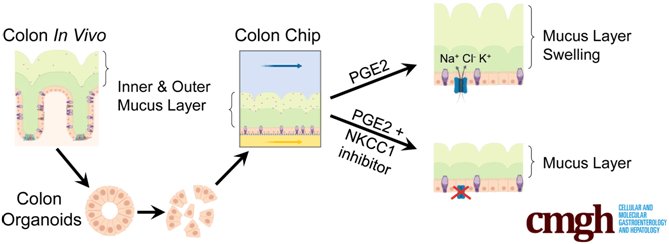
30 Dec Human colon-on-a-chip, created by the Wyss Institute, unveils the physiology of the mucus layer
After the successful design and testing of many types of organ-on-a-chips such as heart on a chip, kidney on a chip, lung on a chip, etc., the Wyss Institute has now unveiled a colon on a chip hoping to gain a better understanding of the human colonic mucus layer.
The mucus layer in the intestine protects the inner layers against luminal commensal bacteria and viruses and pathogens present in the gut. It is a bilayer structure where the inner layer is impermeable to bacteria as opposed to the penetrable outer layer that can reach a thickness of ~600 µm. It is of high importance to keep the integrity of these layers to prevent the colonic epithelium from direct contact with bacteria and potential subsequent inflammation. Despite the significance of the mucus layer in intestinal pathophysiology, it is not feasible to study it in the human body. Ex vivo tissue explants can give a better understanding of this layer but they are limited to short-term (<1 day) experiments. Current in vitro models also come short in creating a thick enough bilayer that is physiologically relevant. Therefore, advanced technologies such as microfluidics can be of help in creating complex in vitro models of the human colon for long-term analyses that are biologically relevant and can mimic the natural conditions of the body.
In their recent paper published in “Cellular and Molecular Gastroenterology and Hepatology”, a team of researchers from Wyss Institute at Harvard reported a human colon-on-a-chip that is capable of modelling the mucus layer with a relevant thickness and bilayer structure as seen in the human body. They combined organ-on-a-chip and organoid technologies to come up with a human colon-on-chip microsystem.
“We showed that a microfluidic 2-channel human Colon Chip enables the long-term culture of primary human colonic epithelial cells under dynamic flow conditions. Moreover, this system supports the spontaneous differentiation of large numbers of highly differentiated, mucus-producing goblet cells at similar levels to those observed in human colon in vivo, while still maintaining a healthy subpopulation of proliferative cells.”, the authors elaborated.
The proposed device was a 2-channel microfluidic chip. The primary human colonic epithelial cells were cultured in the top channel on an ECM-coated layer with 7µm pores. Perfusion of the nutrients through the top and bottom channels allowed the cells to form a confluent flat monolayer. The main material used for microfluidic fabrication was PDMS. The optical transparency of the PDMS microfluidic device made it ideal for real-time non-invasive analysis of the physiology of the layer over-time. The formation of the bilayer was then detected by visually observing the changes in the opacity of the chip over the course of the experiment. To further prove the formation of the bilayer, they took an innovative imaging approach and sliced the PDMS away from the channel and turned it 90o on the side. Darkfield microscopy of the sides confirmed the formation of the bilayer within and its continual growth in the days after. The response mechanism of the mucus layer and changes in its thickness in the presence of various inflammatory mediators can be visually analyzed with this method.
The authors envisioned that the device along with the new advances in bacteria co-culture microfluidic methods can be employed to come up with new drugs for modulating the mucus layer as well as providing a platform for personalized medicine.
Read the original research article: Human Colon-on-a-Chip Enables Continuous In Vitro Analysis of Colon Mucus Layer Accumulation and Physiology

Pouriya Bayat
Pouriya is a microfluidic production engineer at uFluidix. He received his B.Sc. and M.A.Sc. both in Mechanical Engineering from Isfahan University of Technology and York University, respectively. During his master's studies, he had the chance to learn the foundations of microfluidic technology at ACUTE Lab where he focused on designing microfluidic platforms for cell washing and isolation. Upon graduation, he joined uFluidix to even further enjoy designing, manufacturing, and experimenting with microfluidic chips. In his free time, you might find him reading a psychology/philosophy/fantasy book while refilling his coffee every half an hour. Is there a must-read book in your mind, do not hesitate to hit him up with your to-read list.


